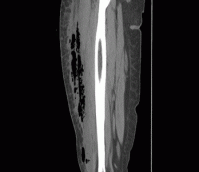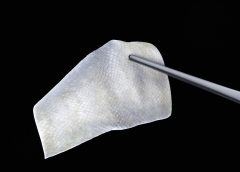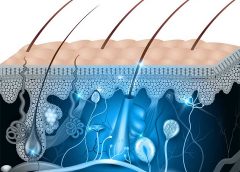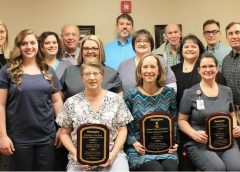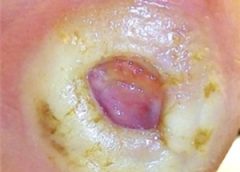LTC Stephen Rush joined the New York Air National Guard as a pararescue flight surgeon with the 103rd Rescue Squadron in 2007. His job was to train and sustain the medical readiness of PJs assigned to the 103rd. He became the medical director for all PJs in 2012. (more…)
Read MoreSearch Results for: cell
Necrotizing Fasciitis: Pearls & Pitfalls
A 39-year-old woman presents to the ED with leg pain and fever. She initially noted redness and pain above her knee 2 weeks ago and was evaluated at an outside hospital. She completed a 10-day course of oral antibiotics for cellulitis. Over the last two days, she has had progressive leg swelling of her entire right thigh. The pain is now so severe that she is having difficulty walking. Her past medical history is negative for diabetes mellitus, chronic liver disease, or alcohol and IV drug use.
On exam, she is febrile to 102.7 F, heart rate is 96 bpm, and blood pressure is 112/65. She has a 12 cm area of faint erythema on her right thigh and tenderness to palpation of her entire right leg with diffuse edema. There is no ecchymosis or bullae formation. (more…)
Read MoreWound healing in diabetic patients improved by Light-inducible antimiRs
MicroRNAs are interesting target structures for new therapeutic agents. They can be blocked through synthetic antimiRs. However, to date it was not possible to use these only locally. Researchers at Goethe University Frankfurt have now successfully achieved this in the treatment of impaired wound healing with the help of light-inducible antimiRs.
MicroRNAs are small gene fragments which bond onto target structures in cells and in this way prevent certain proteins from forming. As they play a key role in the occurrence and manifestation of various diseases, researchers have developed what are known as antimiRs, which block microRNA function. The disadvantage of this approach is, however, that the blockade can lead to side effects throughout the entire body since microRNAs can perform different functions in various organs. Researchers at Goethe University Frankfurt have now solved this problem. (more…)
Read MoreFish Skin for Human Wounds: Iceland’s Pioneering Treatment
The FDA-approved skin substitute reduces inflammation and transforms chronic wounds into acute injuries.
Six hours north of Reykjavik, along a narrow road tracing windswept fjords, is the Icelandic town of Isafjordur, home of 3,000 people and the midnight sun. On a blustery May afternoon, snow still fills the couloirs that loom over the docks, where the Pall Palsson, a 583-ton trawler, has just returned from a three-day trip. Below the rust-spotted deck, neat boxes are packed with freshly caught fish and ice. “If you take all the skins from that trawler,” says Fertram Sigurjonsson, the chairman and chief executive officer of Kerecis Ltd., gesturing over the catch, “we would be able to treat one in five wounds in the world.” (more…)
Read MoreSevere Burn Victims May Soon Be Able to Regrow Hair-Bearing Skin
PolarityTE (TM) Regenerates Full-Thickness Hair-Bearing Skin in Burns and Wounds Using Their Revolutionary Platform Technology. First ever known successful regeneration of full-thickness skin and hair; Company poised to initiate human trial in the third quarter of 2017; Management to host conference call Thursday, June 8th at 4:30pm ET.
Salt Lake City, UT — (Marketwired) — 06/08/17 — PolarityTE™, Inc. (NASDAQ: COOL) today announced pre-clinical results demonstrating that the Company’s lead product, SkinTE™, regenerated full-thickness, organized skin and hair follicles in third degree burn wounds. The findings represent the first known successful regeneration of skin and hair in full-thickness swine wound models, the standard animal model for human skin. The Company expects to initiate a human clinical trial evaluating the autologous homologous SkinTE™ construct in the third quarter of 2017. (more…)
Read MoreLaughlin Center Named Wound Care Center Of The Year
Laughlin Center for Wound Care and Hyperbarics has been honored as the Wound Care Center of the Year as well as recognized with a national award for continued excellence in wound healing by Healogics Inc., a wound care management company.
Leaders, physicians and clinicians from Laughlin Center for Wound Care and Hyperbarics recently gathered to celebrate the center’s receipt of the Robert A. Warriner III Center of Excellence award, according to a news release.
Educational Webinars
Webinars
Covenant Health Wound Care Experts Earn National, Regional Recognition
LUBBOCK, TX (NEWS RELEASE) – The Covenant Center for Wound Care & Hyperbaric Medicine has been honored as a Wound Care Center® of the Year by Healogics, Inc., the nation’s leading and largest wound care management company. The center also was awarded Center of Distinction and the President’s Circle Award.
The center has achieved patient satisfaction rates higher than 92 percent, a healing rate of at least 91 percent in less than 31 median days and healed almost 90 percent of its patients in less than 14 weeks. Out of the 630 Centers eligible in 2016, only seven centers across the country received this prestigious award. Covenant’s center was awarded as Center of the Year for the southwest region, which includes Texas, Oklahoma, Louisiana and New Mexico. (more…)
Read MoreNutritional Supplements
BY: NANCY MORGAN, RN, BSN, MBA, WOCN, WCC, CWCMS, DWC
Wound healing and nutrition go hand in hand. Without adequate fluids, calories, and protein, wound healing can be delayed.
Protein is extremely important in wound healing. Patients with wounds require almost double the protein intake (1.2 to 1.5 g/kg/day) of those without wounds. All stages of wound healing require adequate protein. The basis of the human body structure, protein is responsible for making enzymes involved in wound healing, cell multiplication, and collagen and connective-tissue building. (more…)
Read MoreWound exudate types
BY: NANCY MORGAN, RN, BSN, MBA, WOCN, WCC, CWCMS, DWC
What exactly is wound exudate? Also known as drainage, exudate is a liquid produced by the body in response to tissue damage. We want our patients’ wounds to be moist, but not overly moist. The type of drainage can tell us what’s going on in a wound.
Let’s look at the types of exudates commonly seen with wounds. (more…)
Read MoreHow are you differentiating the “big three”?
BY: NANCY MORGAN, RN, BSN, MBA, WOCN, WCC, CWCMS, DWC
Lower extremity ulcers are often referred as the “big three”—arterial ulcers, venous ulcers, and diabetic foot ulcers. Are you able to properly identify them based on their characteristics? Sometimes, it’s a challenge to differentiate them.
Arterial ulcers tend occur the tips of toes, over phalangeal heads, around the lateral malleolus, on the middle portion of the tibia, and on areas subject to trauma. These ulcers are deep, pale, and often necrotic, with minimal granulation tissue. Surrounding skin commonly is pale, cool, thin, and hairless; toenails tend to be thick. Arterial ulcers tend to be dry with minimal drainage, and often are associated with significant pain. The patient usually has diminished or absent pulses. (more…)
Read More
